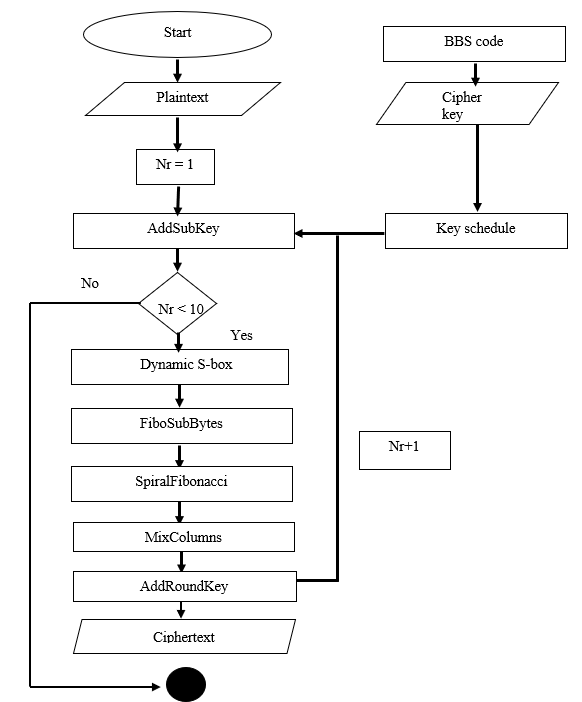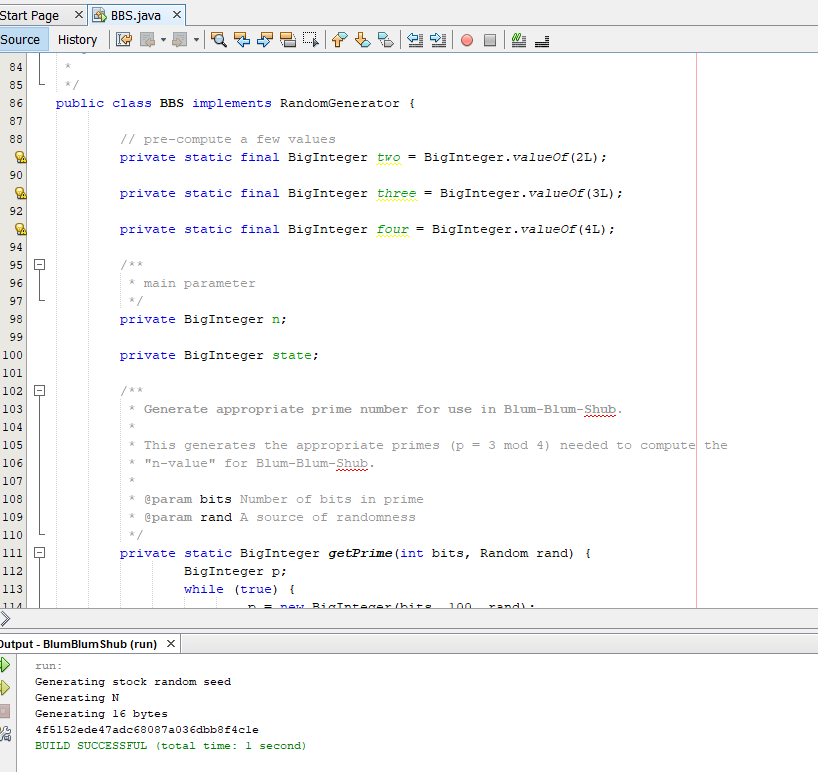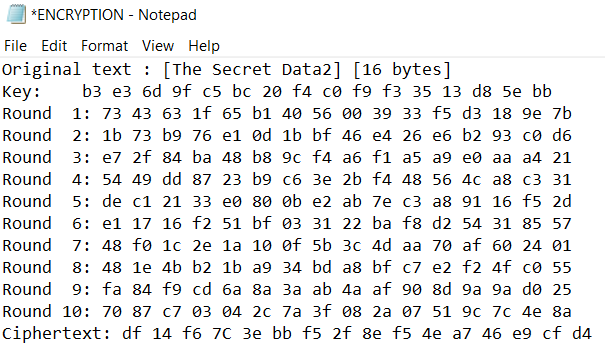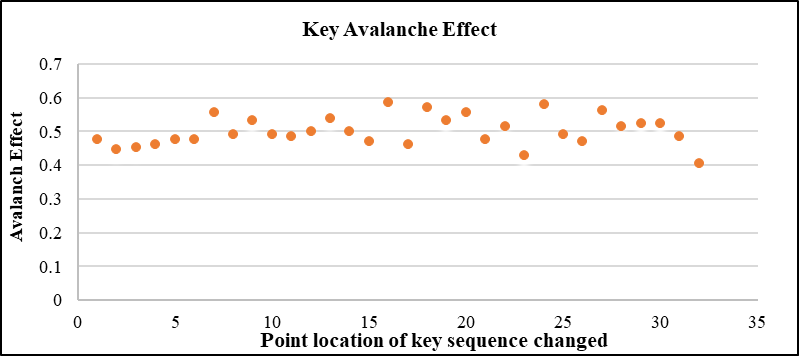Abstract
Developments in computers and technologies have created an intense need for secure and trustworthy cryptography systems. Highly secure schemes are always desirable for real-world applications. Cryptography requires a secure technique to ensure that the enemy is prevented while securing legitimate users who have access to the data. The avalanche effect is one of the most preferred approaches for determining an algorithm's security in cryptography. In this paper, the experimental process is conducted to examine the sensitivity of the algorithm when a one-bit input is changed in the key, which causes changes on approximately half of the ciphertext. The experiment is performed based on the key avalanche in the proposed block cipher algorithm. These processes were done 32 times based on the 32-bit plaintext on the algorithm and the avalanche effect was calculated in each time based on the ciphertext generated. However, if a block cipher does not exhibit the avalanche effect to a significant degree, it indicates that it has weak randomisation. Hence, the input can be predicted by a cryptanalyst, while only being given the output. From the experiment, the findings revealed that the proposed block cipher algorithm met the key avalanche with a 50% output bit changed in the ciphertext. Therefore, the proposed block cipher scheme satisfies the avalanche effect property, resulting in improved diffusion.
Keywords:
Introduction
Cryptography has emerged as the most important approach for protecting data against unauthorized access. Cryptography has always been in our daily lives. Almost every time we use the Internet to make a payment, check an account, send and receive an email, make a purchase, and so on. However, data must be protected from hacking, noise, and interference due to the widespread use and sharing of data on the Internet (Yassein et al., 2017). Therefore, cryptography allows two or more parties to communicate securely. In order to communicate securely, the key is needed to hide and protect the information. Cryptography requires a secure technique to ensure that the enemy is prevented while securing legitimate users to gain access to information. Thus, the design of symmetric key cryptography is often enhanced to ensure that information is secure. Meanwhile, symmetric key cryptography is utilized in a variety of applications to protect data. This technique is called a secret key where the same key is used to encrypt or decrypt the data. Encryption means that the plaintext is converted into the ciphertext while decryption means that the ciphertext is converted into the plaintext. According to Latif et al. (2020) encryption is an excellent countermeasure against hackers' vulnerabilities, and it aids in the achievement of confidentiality, integrity, and authentication. For both processes, the key is required to encrypt and decrypt the data. Block cipher and stream cipher are two types of symmetric key ciphers. Block cipher contains the block of plaintext with the fixed-length while stream cipher is used to encrypt data one bit or byte at a time. The encryption algorithm is determined by the key in cryptography. If a single bit change in the key has an effect on the number of bits in the cipher (Singla & Bala, 2018). In this paper, the proposed algorithm is designed based on a block cipher. Moreover, Emami (2013) stated that to gain confidence in the security of these algorithms their analysis is always as important as their designs. Therefore, the proposed algorithm will be examined using the strict avalanche effect to determine the algorithm's security requirements. The structure of this paper as follows: In Section 1.1, an overview of an avalanche effect is discussed. The problem statement is stated in Section 2. Section 3 contains research questions and a proposed study is discussed in Section 4. In Section 5, a research method is described and in Section 6, a finding of the proposed algorithm is described and in Section 7, a conclusion is given.
Overview of an Avalanche Effect
According to Simion (2015) while developing cryptography primitives, they must meet several statistical criteria, which is a strict avalanche. The strict avalanche effect was introduced in 1985 by Webster and Tavares. It defines to a special and desirable characteristic of cryptographic algorithms. It describes a situation in which an input flips a single bit, causing the half-bit flip output to shift dramatically. For example, if a one-bit input change in plaintext or key causes the output bit to change with a probability of ½ bits in the ciphertext, meets the avalanche criterion based on the function. Besides, it is harder to perform an analysis of ciphertext, when trying to come up with an attack (Mohamed et al., 2014).
The avalanche effect is one of the most essential factors to consider when assessing a cryptographic algorithm's strength (Ramanujam & Karuppiah, 2011). A study by Nazeh et al. (2018) found that the avalanche effect reflects performance of cryptographic algorithm. In addition, Echeverri (2017) stated that secure cryptographic algorithms must have a strong avalanche effect with a probability of a 50% change in output. Shi et al. (2011) analysed the avalanche effect on the AES S-box and inverse S-box, which then concluded that both S-boxes of AES have a good avalanche effect. Bhoge and Chatur (2014), also demonstrated a good avalanche effect of the AES block cipher. The results obtained were 0.3593, 0.4921, and 0.4453, respectively. Then, Shi et al. (2011) analysed the KASUMI block cipher based on the avalanche effect. When plaintext 50 and 51 bits were altered, 40 bits of the corresponding ciphertext were changed. The average change bit of the ciphertext was 32.2%, almost half of 64 bits. The result shows that the plaintext of the KASUMI algorithm has a good input avalanche effect. Alabaichi and Mechee (2015) analysed the Blowfish algorithm between plaintext and ciphertext. The result indicated different numbers of bits in ciphertext when there was a change of one bit in plaintext. From the results, the Blowfish algorithm presented a good avalanche with a total number of 64-bit sequences. According to Raju et al. (2017), the avalanche effect was considered an isolated check on the integrity of the algorithm. For the avalanche effect, DES has a good avalanche effect of 54.38%. Encarnacion et al. (2020) found that the SIMECK block cipher family's increased round function approach for testing security using the avalanche effect, runtime performance, and brute-force attack on the output ciphertext and its performance. Therefore, the avalanche effect is a desirable property of a block cipher. It is satisfied if each output bit changes with a 50% probability whenever a single input bit is complemented. The presented work resulted in a significant increase in the avalanche effect of the resulted ciphered word.
Research Questions
In accordance with the above discussion, this study aims to concentrate on the principal research question:
Is there an avalanche effect in the ciphertext?
How avalanche effect ensure data security the algorithm?
How to increase security requirements in the algorithm?
Purpose of the Study
The proposed block cipher is designed to improve the design of the substitution and permutation functions. For the proposed block cipher; the length of the input, output block, and the State were 128 bits. The State is a 4x4 matrix consists of rows and columns, = 4 denotes the number of 32-bit words and columns in the State. The length of the cipher key,, consists of 128 bits; The key length is represented by= 4. The number of rounds was represented by, where=9 when= 4. The proposed block cipher algorithm's design is shown in Figure 1.

At the start of the Cipher, the plaintext input was copied to the State array. Then, the algorithm took the cipher key, from the BBS code (Blum-blum Shub). The BBS is a program used to generate a random cipher key. After that, it used a Key Expansion algorithm to create the Key Schedule. The Key Expansion was used to create a two-dimensional array of four-byte words. The Key Expansion process was similar to the AES block cipher module. The Key Expansion then generated a total of(+ 1) words: the algorithm required an initial set ofwords, and each of therounds requiredwords of key data. In the transformation, a RoundKey was added to the State by a simple bitwise XOR operation. Then, the application of the transformation to therounds of the Cipher occurred when≤≤. After an initial RoundKey addition, the State array was modified by applying a round function 9 times. Thus, an S-box was initialised using a key from the AddSubKey(). The proposed block cipher consisted of FiboSubBytes, SpiralFibonacci, MixColumns and AddRoundKey. was performed after In the, a round key was added to the State by a simple bitwise XOR operation. Each processing round worked on an array of input State and produced an array of output State until the number of rounds became less than 10.
Research Methods
The experiment investigated the impact of the output if one bit of input is altered in plaintext or key. First, the data were prepared based on the 32-bit random key and plaintext. The data were generated through the BBS program as shown in Figure 2.

In the random key data block, one bit in the 32-bit key was changed for the key avalanche effect. For the plaintext avalanche effect, one bit in the 32 bits plaintext was changed in the plaintext block. Then, an experimental process was performed to encrypt the key and the plaintext block to derive the initial ciphertext. This process was performed on the algorithm by 32 times and the effect of the avalanche was calculated each time based on the generated ciphertext. Based on Antonio et al. (2019) ciphertext was mapped in binary code to determine an avalanche effect as stated in Equation 3.1.
Avalanche Effect = Number of flipped bits in ciphertext (3.1)
Number of bits in ciphertext
Figure 3 shows the key and the plaintext (original text) of the proposed block cipher. Based on the experiment, the sensitivity of the algorithm is examined when one-bit input is changed in the key. For example, the key is “b3 e3 6d 9f c5 bc 20 f4 c0 f9 f3 35 13 d8 5e bb” , the plaintext is “The Secret Data2” and ciphertext is “df 14 f6 7C 3e bb f5 2f 8e f5 4e a7 46 e9 cf d4”.

Before the proposed block cipher encrypts the encryption key and inputs plaintext, they are mapped into separate binary codes. Finally, the result was analysed based on a small change in the key with a significant change in the ciphertext. Therefore, if a block cipher does not exhibit the avalanche effect to a significant degree, it indicates that it has poor randomisation, thus allowing a cryptanalyst to make predictions about the input being given only the output..
Findings
The experiment was conducted to examine the sensitivity of the algorithm when a one-bit input is changed in the key or plaintext, which causes changes on approximately half of the ciphertext. If a block cipher does not exhibit the avalanche effect to a significant degree, then it has poor randomisation, which would allow a cryptanalyst to make predictions about the input, being given only the output. The experiment was performed based on the key avalanche avalanche as follows.
Key Avalanche Effect
In this experiment, for the key avalanche effect, one character in the 32-bit key was changed. This process was carried out in 32 times on the algorithm and the avalanche effect was determined based on the generated ciphertext. The result showed that half of the ciphertext was changed by a single bit change in the key. A value of the avalanche effect close to 0.5 is considered sufficient. From the result explained in Table 1, the key avalanche effect values of the proposed block cipher were provided. The small value of the avalanche effect was 52(0.4063) while the highest value was 73(0.5703). It was obvious that the average avalanche effect value of the algorithm was equal to 0.5.
Figure 4 shows the scatter plot in the proposed algorithm for the key avalanche effect. The value of the avalanche effect was nearly 0.5, which is considered sufficient. From these results, it appears that the proposed block cipher algorithm exhibited a good avalanche effect to have better randomness. The outcome of this analysis is that the proposed algorithm has satisfied the key avalanche effect with a 50% output bit changed in ciphertext. It shows a significant increase in the key avalanche effect on the algorithm. Therefore, this result indicated that the proposed block cipher algorithm satisfied the avalanche effect.

In fact, the Data Encryption Standard (DES) has a good avalanche effect of 54.38% similar to the proposed block cipher algorithm, the results demonstrated that the avalanche effect satisfied with a 50% output bit change. It can be concluded that the proposed algorithm has fulfilled the avalanche effect property resulting in better diffusion.
Conclusion
In conclusion, an avalanche effect shows that when an input is slightly changed, the output dramatically changes the proposed block cipher algorithm. Through experiment, the results showed that the proposed block cipher algorithm satisfied the avalanche effect with a 50% output bit changed. It can be concluded that, the proposed block cipher algorithm fulfilled the avalanche effect property resulting in better diffusion. Thus, the results obtained proved that the output of the proposed block cipher algorithm is random irrespective of the input. It shows that the algorithm hides all useful information about the original data. Therefore, the proposed block cipher algorithm has the potential to raise security requirements.
References
Alabaichi, A., & Mechee, M. S. (2015). Evaluation of a Dynamic 3D S-Box Based on Cylindrical Coordinate System for Blowfish Algorithm. Journal of Applied Sciences, 15(5), 728-740. https://doi.org/10.3923/jas.2015.728.740
Antonio, R. B., Sison, A. M., & Medina, R. P. (2019). A modified generation of S-box for advanced encryption standards. In Proceedings of the 2019 2nd International Conference on Information Science and Systems (pp. 280-283).
Bhoge, J. P., & Chatur, P. N. (2014). Avalanche Effect of AES Algorithm. International Journal of Computer Science and Information Technologies, 5(3), 2014, 3101-3103. https://citeseerx.ist.psu.edu/viewdoc/download?doi=10.1.1.659.9331&rep=rep1&type=pdf
Echeverri, C. (2017). Visualization of the Avalanche Effect in CT2 [Doctoral dissertation, University of Mannheim]. https://www.cryptool.org/assets/ctp/documents/BA_Echeverri.pdf
Emami, S. S. (2013). Security analysis of cryptographic algorithms. A thesis for the degree of Doctor of Philosophy. Department of Computing, Faculty of Science Macquarie University.
Encarnacion, P. C., Gerardo, B. D., & Hernandez, A. A. (2020). Performance Analysis on Enhanced Round Function of SIMECK Block Cipher. In 2020 12th International Conference on Communication Software and Networks (ICCSN) (pp. 270-275). IEEE.
Latif, M. A., Ahmad, M. B., & Khan, M. K. (2020). A Review on Key Management and Lightweight Cryptography for IoT. In 2020 Global Conference on Wireless and Optical Technologies (GCWOT) (pp. 1-7). IEEE.
Mohamed, K., Pauzi, M. N. M., Ali, F. H. H. M., Ariffin, S., & Zulkipli, N. H. N. (2014). Study of S-box properties in block cipher. In 2014 International Conference on Computer, Communications, and Control Technology (I4CT) (pp. 362-366). IEEE.
Nazeh, A. W. M., Ali, A., Esparham, B., & Marwan, Md. (2018). A Comparison of Cryptographic Algorithms: DES, 3DES, AES, RSA and Blowfish for Guessing Attacks Prevention. Journal of Computer Science Applications and Information Technology, 3(2), 1-7.
Raju, B. B., Krishna, A., & Mishra, G. (2017). Implementation of an efficient dynamic AES algorithm using ARM based SoC. In 2017 4th IEEE Uttar Pradesh Section International Conference on Electrical, Computer and Electronics (UPCON) (pp. 39-43). IEEE.
Ramanujam, S., & Karuppiah, M. (2011). Designing an algorithm with high Avalanche Effect. IJCSNS International Journal of Computer Science and Network Security, 11(1), 106-111. http://paper.ijcsns.org/07_book/201101/20110116.pdf
Shi, H., Deng, Y., & Guan, Y. (2011). Analysis of the avalanche effect of the AES S box. In 2011 2nd International Conference on Artificial Intelligence, Management Science and Electronic Commerce (AIMSEC) (pp. 5425-5428). IEEE.
Simion, E. (2015). The relevance of statistical tests in cryptography. IEEE Security & Privacy, 13(1), 66-70.
Singla, S., & Bala, A. (2018). A review: cryptography and steganography algorithm for cloud computing. In 2018 Second International Conference on Inventive Communication and Computational Technologies (ICICCT) (pp. 953-957). IEEE.
Yassein, M. B., Aljawarneh, S., Qawasmeh, E., Mardini, W., & Khamayseh, Y. (2017). Comprehensive study of symmetric key and asymmetric key encryption algorithms. In 2017 International Conference On Engineering And Technology (ICET) (pp. 1-7). IEEE.
Copyright information

This work is licensed under a Creative Commons Attribution-NonCommercial-NoDerivatives 4.0 International License.
About this article
Publication Date
31 October 2022
Article Doi
eBook ISBN
978-1-80296-958-0
Publisher
European Publisher
Volume
3
Print ISBN (optional)
-
Edition Number
1st Edition
Pages
1-802
Subjects
Multidisciplinary sciences, sustainable development goals (SDG), urbanisation
Cite this article as:
Mohamed, K., Mohammed Pauzi, M. N., Hj Mohd Ali, F. H., & Ariffin, S. (2022). Analyse On Avalanche Effect In Cryptography Algorithm. In H. H. Kamaruddin, T. D. N. M. Kamaruddin, T. D. N. S. Yaacob, M. A. M. Kamal, & K. F. Ne'matullah (Eds.), Reimagining Resilient Sustainability: An Integrated Effort in Research, Practices & Education, vol 3. European Proceedings of Multidisciplinary Sciences (pp. 610-618). European Publisher. https://doi.org/10.15405/epms.2022.10.57

